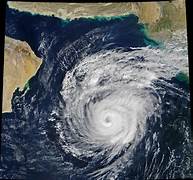Published on: June 10, 2023

Cyclone
Cyclone

Why in news? A cyclonic storm, named Biparjoy, has developed in the Arabian Sea.
Highlights:
- According to an Indian Meteorological Department (IMD) a, the cyclone would result in squally weather with wind speeds reaching 35-45 kmph along the coastline of Karnataka, Goa and Maharashtra.
How did Cyclone Biparjoy get its name?
- ‘Biparjoy’ was suggested by Bangladesh and the word means ‘disaster’ or ‘calamity’ in Bengali.
How are cyclones named?
- The naming of cyclones is done by countries on a rotational basis, following certain existing guidelines.
- Worldwide, there are six regional specialised meteorological centres (RSMCs) and five regional Tropical Cyclone Warning Centres (TCWCs) mandated for issuing advisories and naming of tropical cyclones.
- IMD is one of the six RSMCs to provide tropical cyclone and storm surge advisories to 13 member countries under the WMO/Economic and Social Commission for Asia-Pacific (ESCAP)
- RSMC, New Delhi is also mandated to name the Tropical Cyclones developing over the north Indian Ocean (NIO), including the Bay of Bengal (BoB) and the Arabian Sea (AS).
- The WMO/ESCAP Panel on Tropical Cyclones in 2000 agreed in principle to assign names to the tropical cyclones in these seas
Is it not rare for cyclones to develop in the Arabian sea?
- There are fewer number of cyclones in the Arabian Sea than the Bay of Bengal, but it is not uncommon.
- In fact, June is one of the favourable months for the formation of cyclones in the Arabian Sea.
- Bay of Bengal is slightly warmer. Because of climate change, the Arabian Sea side is also getting warmer, and as a result, the number of cyclones in the Arabian Sea is showing an increasing trend in the recent trend.
Why there is a higher number of cyclones in Bay of Bengal than Arabian sea?
- A cyclone is a low-pressure system that forms over warm waters.
- Usually, a high temperature anywhere means the existence of low-pressure air, and a low temperature means high-pressure wind. This is one of the main reasons for greater number of cyclones in the Bay of Bengal compared to Arabian Sea.
- As warm air rises and cools, water vapour condenses to form clouds and this can lead to rains.
- Weather systems formed over the Bay of Bengal in the peak of summer in May are among the strongest in the North Indian Ocean region.
- Warm seas present ripe conditions for the development and strengthening of cyclones and fuel these systems over the water.
Global warming impact on Cyclones
- The impact of global warming on the monsoons are manifest in its onset, withdrawal, seasonal total rainfall, and extremes
- Global warming affects the cyclones over the Indian Ocean and the typhoons over the northwestern Pacific Ocean and making the atmosphere more hostile to the formation of tropical cyclones.
- Cyclone formations in the pre-monsoon cyclone season, closer to the monsoon onset, arguably due to the influence of a warmer Arctic Ocean on the winds over the Arabian Sea.
- The compounding effects from floods, storm surge, and terrestrial flooding (rivers) are projected to increase due to global warming.

